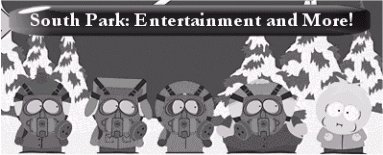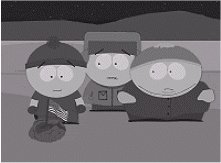

For some reason, South Park, an animated television show featuring eight-year
old kids, has struck fear in the hearts of many people, such as my parents.
They feel that the consistent swearing of the children in this cartoon
is obscene and vulgar; therefore, the show must have low morals and no
educational value. However, if they were to actually sit down and
watch an entire episode, I am sure they would be surprised by just how
informative, educational, and entertaining South Park really is.
Almost every episode relates to real world current events, yet this does
not take away from the entertainment of the show.
Another point worth mentioning is that television shows and movies say
a lot about the writers themselves. We get to know the writers through
their television shows, just as we can get to know a person by the type
of home they have or the types of clothes they wear. For example,
people who want the world to know how well they have done financially will
wear expensive clothes and live in huge houses (Kron 95). Writers
of television programs have a much bigger advantage because they have the
ability to air their opinions, beliefs, and who they are on television
for the world to see. They can be as subtle or direct about it as
they wish.
The episode aired on November 7th, 2001, was about the current fight against
terrorism. It opened with the familiar characters, Stan, Kyle, Eric,
and Kenny, boarding their school bus with gas masks while talking about
the anthrax scare. Eric Cartman makes a very memorable statement
during the course of their conversation. “We’re just kids!
There’s a lot of stuff going on in the world, but we’re just caught in
the middle. It’s not our fault.” Government officials never
seem to think about how innocent children are involved as they continue
to bomb countries. The writers of South Park are subtly getting the
point across that innocent people and children’s lives are being affected
by this war. This is a very serious statement, yet coming out of
the mouth of this pudgy little cartoon character whom is known for his
ignorance, it is quite humorous.
Once Cartman and the others are inside the classroom, they all remove their
gas masks. This implies that the students are “safe” and “sheltered”
from the real world once inside the classroom. They are taught in
school that everybody loves America and that we have no enemies.
This lesson has been proven false by the recent terrorist attacks on the
United States. Here, the writers are selling the idea that what we
are taught in the classroom may not be entirely true, and that we should
question the things we hear from authority figures.
Each student is asked to send a dollar to the children in Afghanistan.
I find it ironic that America should still try to play the role of “big
brother” while bombing the country at the same time. Their reasoning
behind this is probably to show that we do not hate all Afghanistan people,
only terrorists. However, when we bomb the country, we are harming
the innocent ones as well. Cartman protests saying that we should
not send them anything because we hate Afghans. Wendy, a classmate
of the boys, replies “The war’s with terrorism asshole, not Afghanistan!”
This is something many of us tend to forget. The writers are probably
trying to get the veiwer to realize something that they may have been neglecting
to understand. After this scene, we switch over to Afghanistan.
In Afghanistan we see four children, parallel to Stan, Cartman, Kyle, and
Kenny in looks and behavior. They try to enjoy themselves by playing
basketball, when a bomb drops from the sky and lands on the basketball
hoop exploding it. They attempt going to see a movie when a bomb
falls and blows up the theater. The children are very upset, but
each receives an envelope in the mail with a dollar in it from the Americans.
This gives the impression that Americans feel all problems can be solved
with money. The Afghan kids, in exchange for the four dollars the
American kids sent, send a goat to America. They explain that it
is their culture to send gifts in return for gifts they receive, and because
everything around them was being blown up, the only thing they could think
of to send was a goat. It seems as if the writers of South Park are
sympathizing with Afghans.
Cartman and the rest of the gang agreed that none of them were able to
keep a goat, so they decided to ship it back to Afghanistan. They
wind up getting locked in the plane and shipped off to Afghanistan where
they meet up with the children there and return the goat. Stan offers
the children a little American flag, which they promptly burn. Stan
is confused and says, “They told us in school everyone loves America!”
This is proof of what was implied earlier in the classroom. It is
also something I can relate to because I felt the same way when I heard
we were being attacked.
Later in the conversation, one of the Afghan children says, “You don’t
realize one third of the world hates you!” He also informs the children
that: “Americans started this war years ago when they put military
bases on Muslim holy land!”. South Park is trying to inform its viewers
that America is not perfect, and that we are not as “looked up to” by all
of the other countries as we think we are. They also seem to be stressing
the point that we are not necessarily the innocent, unsuspecting victims
that we appear to be in this war, and that maybe we should review the facts
a little closer.
When the children of South Park are captured by Osama Bin Laden and his
gang, the Afghan children save them stating: “If we don’t help the
innocent ones, we’re no better than the Americans.” This relates
heavily to what is going on between the United States and Afghanistan today.
America is sinking to the level of those they claim to hate by killing
innocent people who had nothing to do with what happened. This quote,
especially coming from a child, is a great way to make people realize how
stupid and childish they are acting by wishing to harm innocent people
in the pursuit of Osama Bin Laden.
Many different types of people are referenced in this episode as different
characters. Such as:
The
shocked – Stan’s mother represents the people who went into shock after
seeing the news. She is addicted to watching, and all she does is
lie on the couch all day and night. At one point Stan’s dad comments,
“Sharon, you’ve been watching CNN for about… uh… 8 weeks now. Don’t
you wanna watch something else?”
The
angry – These are the people who do not know how to react to what has
happened so they simply want to fight. When the Afghan children sent
the goat to the United States, almost the whole neighborhood surrounded
it anticipating something terrible and ready to blow it up.
The
ignorant – When the children end up in Afghanistan, one of them remarks
“Dude, no wonder terrorists come from places like this. If I grew
up here I’d be pissed off too!”
Not
only do the people of South Park closely resemble those of the real world
Americans, but the town also looks similar in that there are American flags
all over the place. The whole episode runs parallel to what is  going
on the world right now. Perhaps the most important part of the show
is when young Stan removes his coat and wraps it around the bottom of a
little flag, helping it to stand up on its own. He comments that
the Afghan kids almost made him ashamed of America, but he realizes that
we have to stand up for our country. As much as the writers criticized
the war and made fun of both Afghans and Americans, this final act sums
up how they feel about America. It is kind of a reminder that we
should not turn our backs on our country, even if things end up getting
out of hand. “America’s like a team. If you don’t wanna root
for your team you should get the hell out of the stadium,” comments Stan.
going
on the world right now. Perhaps the most important part of the show
is when young Stan removes his coat and wraps it around the bottom of a
little flag, helping it to stand up on its own. He comments that
the Afghan kids almost made him ashamed of America, but he realizes that
we have to stand up for our country. As much as the writers criticized
the war and made fun of both Afghans and Americans, this final act sums
up how they feel about America. It is kind of a reminder that we
should not turn our backs on our country, even if things end up getting
out of hand. “America’s like a team. If you don’t wanna root
for your team you should get the hell out of the stadium,” comments Stan.
When this show first aired a few years back, the episodes were no less
humorous than they are today, but I can not think of a single episode from
the first volume that dealt with a serious issue or current event. Maybe
now that the writers have earned the attention of a wide range of people,
they are interested in discussing more serious issues with their viewers.
Afterall, our identities “flicker and fade like ailing light bulbs (Kron
102).” Perhaps the writers of South Park are maturing in a way.
This episode of South Park ran parallel to a very serious matter going
on in the world right now. The writers made no effort in hiding this,
probably because they wanted the viewer to think about different points
of view on this issue instead of simply getting angry and wanting to kill
anyone who is not American. The fact that the children swear frequently
during the show may be a turn off for the older generation, but the younger
generation seems to be attracted to that type of language. I do not
feel that the use of such language is to “shock” the viewer, as my parents
would say. I feel that it is to “lure” the viewer – to grab the attention
of the viewer encouraging him or her to stay and watch more, perhaps to
see what will happen next.
According to Andy Warhol, in our fast-paced media world, no one can count
on being a celebrity for more than fifteen minutes (Kron 95). I beg
to differ. South Park has been on the air for years now and has not
lost a single shred of its popularity. South Park, in my opinion,
is hilarious. There are not too many television shows out there today
that are willing to even try to add humor to what is going on with Afghanistan.
As shocking as the language may seem, and as realistic as the events may
be, this show never ceases to entertain.
Works Cited
Kron, Joan. “The Semiotics of Home Décor.” Signs
of Life in the USA. Third Edition.
Boston : Bedford
/ St. Martin’s, 2000. 94-104.
All South Park pictures came from the following website:
<http://www.southparkstudios.com/down/guide.html?id=509/>